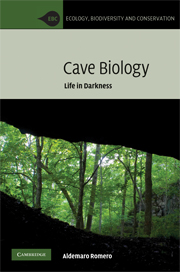Book contents
- Frontmatter
- Contents
- Preface
- Acknowledgments
- 1 A brief history of cave biology
- 2 Cave biodiversity
- 3 The evolutionary biology of cave organisms
- 4 The ecology of cave organisms
- 5 Cave conservation and management
- 6 Epilogue
- Appendix 1 Glossary of terms frequently used in biospeleology
- References
- Index
- Plate section
2 - Cave biodiversity
Published online by Cambridge University Press: 21 October 2009
- Frontmatter
- Contents
- Preface
- Acknowledgments
- 1 A brief history of cave biology
- 2 Cave biodiversity
- 3 The evolutionary biology of cave organisms
- 4 The ecology of cave organisms
- 5 Cave conservation and management
- 6 Epilogue
- Appendix 1 Glossary of terms frequently used in biospeleology
- References
- Index
- Plate section
Summary
It has been conventional wisdom for many years to consider caves as depauperate ecosystems in terms of both biodiversity and biomass. Such a notion derives from a confluence of factors: the lack of primary producers for the most part, the limitations of space, and the fact that most studies have been done in temperate latitudes, in which caves are rather poor in terms of biodiversity when compared with their tropical counterparts. This chapter surveys the biodiversity in caves to demonstrate (a) that there is a large array of taxa represented in these ecosystems and (b) that the role played by many of these organisms is much more important than previously acknowledged. Some of the biological phenomena that occur throughout hypogean biodiversity, and that will be synthesized later on in the other chapters of this book when dealing with issues related to evolution, ecology, and conservation, are also highlighted.
This survey follows the conventional list of major taxa found in most general biodiversity sources. Although the systematics of all major living groups is always changing and subject to discussion, it is preferable to follow a list of names that are familiar to the general reader, since phylogenetic discussions are beyond the scope of this book.
Bacteria (Archaeobacteria and Eubacteria)
Introduction
In the past all bacteria were classified under a single umbrella (prokaryotes) but better understanding of their relationships through new molecular techniques has split them into two major groups: Archaeobacteria and Eubacteria.
- Type
- Chapter
- Information
- Cave BiologyLife in Darkness, pp. 62 - 129Publisher: Cambridge University PressPrint publication year: 2009

